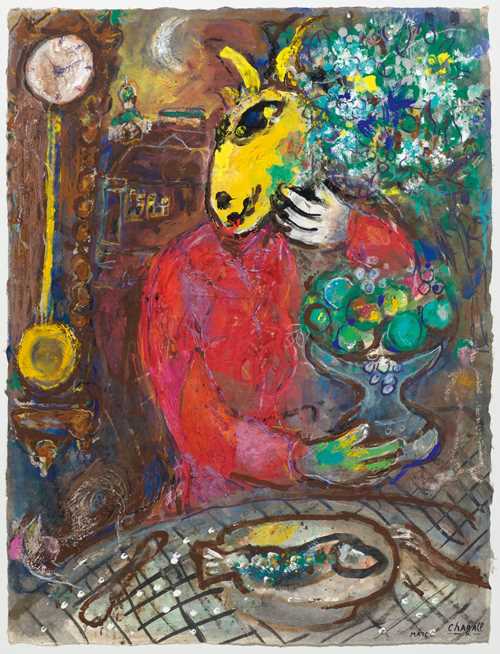
Lot 3540 - A193 Art Impressionniste & Moderne - vendredi, 03. juillet 2020, 16h00
MARC CHAGALL
Collection V. Loeb, Muri near Bern, presumably purchased directly from the artist and by descent to the present owner.
Exhibition:
Berlin 1972–73, Marc Chagall, Gouachen und Lavis 1947 bis heute, Nationalgalerie Berlin, Staatliche Museen Preussischer Kulturbesitz, 17 November 1972–22 January 1973, p. 34, no. 67 (with col. ill. p. 20).
Literature:
Franz Meyer, Marc Chagall. Leben und Werk, Cologne, p. 151, no. 1007 (with ill.).
“A young Russian painter, a tremendously imaginative colourist who always transcends the moody imagery of Slavic folk art, which he sometimes recalls. He is an artist of enormous versatility who defies all theories” (Apollinaire on Chagall, quoted in: Jacob Baal-Teshuva, Marc Chagall, 1998, p. 72).
Marc Chagall understood most of his later works as a return to his beginnings — the spark of first love, the retrieval of the child-like excitement with which he embraced the simplest pleasures in life while simultaneously embracing the temporary sadness of transience and loss.
“La veste Rouge” is a fantastic example of Marc Chagall's late work and contains many of the artist's most popular motifs and themes. In the foreground, Chagall has depicted a hybrid creature, a human body with a goat’s head. These hybrid half-human, half-animal figures that so often appear in Chagall’s work originate from an old tradition. They can be found in old Jewish prayer books and manuscripts from the 13th and 14th centuries, in which the figures from Scripture are depicted as figures with animal heads. Chagall's Hasidic upbringing had a strong influence on his entire work and it is obvious that Chagall knew these Jewish texts and used them as sources for his motifs.
Animals generally play a central role in Chagall's oeuvre. They are rarely seen as allegories, but rather as protagonists who act as people; the goat in particular plays a human role in many of the artist's paintings. Even in his early self-portraits, Chagall often depicted his head in a peculiar way. First detached from the neck and turned 180 degrees, sometimes with two human faces in one, or then together with an animal head. Of the latter, Chagall produced some lithographs around 1960. They depict a human body and a head that is half-human and half-animal. Thus it stands to reason that Chagall went one step further in “La veste rouge” and completely replaced his own head with that of a goat. It also can be assumed that the present work is a self-portrait. Chagall portrayed himself again in the 1980s, shortly before his death, in the same red jacket worn by the protagonist in the present work.
Surrounding this self-portrait, the artist has embedded himself amidst his own story. Indicated in the background are the rooftops of his hometown Vitebsk. Even after he left for Paris in 1922, the city with its distinctive buildings and rural character remained a fundamental source of inspiration, which he described as: "the soil that nourished the roots of my art" (M. Chagall, quoted in: J. Baal -Teshuva, Marc Chagall: 1887-1985, New York, 1998, p. 19). They are a remembrance of his parents and siblings, of his Jewish heritage and many traditions, and also of the difficulties of his childhood due to his family's financial hardships and the anti-Semitism that they had to face. The large pendulum clock, which Chagall has placed at the side, appears in a number of the artist's pictures. In 1914 he even dedicated an entire painting to the clock case. Time is pervasive, sometimes it seems to stand still, sometimes it rattles along quickly, but it cannot be escaped, as Chagall repeatedly pointed out. The still-life quality of the composition in the foreground is typical of Chagall, and especially the combination of fish, fruit and flowers can be frequently found in the artist's late work.
These often very personal motifs for Chagall were immersed in his own colour palette, frequently composed of bright colours. He has placed himself at the centre of the present work, which is further emphasised through the luminous colours of the red jacket and the yellow goat head. The background, the past, remains reserved and is rendered in shades of brown.
"My paintings are my memories" (M. Chagall, ibid. p. 265), described Chagall. The combination of personal history, Jewish tradition and mystical creatures make Chagall a unique artist who was well received during his lifetime and still celebrates success long after his death
CHF 300 000 / 450 000 | (€ 309 280 / 463 920)
Vendu pour CHF 341 900 (frais inclus)
Aucune responsabilité n'est prise quant à l´exactitude de ces informations.

